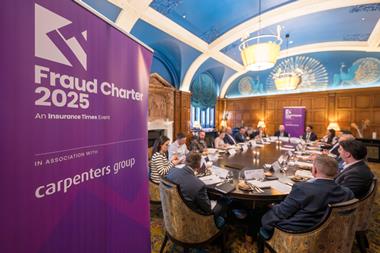The stand-alone terrorism market is experiencing considerable growth with capacity flooding in. Andrew Holt explains why
?It has been something of a roller coaster ride for the stand-alone terrorism market since 9/11. It began to mature in 2003 and the loss of business to Tria – the US funding pool set up under legislation to meet terrorism claims – and other government solutions/pools contributed to the market softening.
The picture now though is there are more underwriters and brokers involved in the market, creating greater competition and resulting in a decline in rates by 50%-60% since 2002, according to Aon.
Will Farmer, a director of Aon Crisis Management, says: “The stand-alone terrorism insurance market has matured greatly since 9/11. Capacity has grown steadily, premium rates have become more predictable and programme design increasingly imaginative.
“Demand is still strong. Most existing buyers renew, and there is a stream of new buyers of the stand-alone product.”
And he adds that brokers and insurers continue to refine the stand-alone product. “The increased use of captive insurers, self-insured retentions, hybrid programmes and other risk management tools have all assisted in making the product more attractive.”
Since January 2006, readily accessible capacity has increased by around 20%. Market capacity, grew rapidly in 2002 and 2003. Currently this is in excess of $ 2bn. But much of this was derived from existing underwriters increasing their capacity.
Tim Press, a director in the specialist risk department at Miller Insurance, says: “There is big competition on pricing and I think some have made a line in which they will not go south of. What this has meant is an array of new products that underwriters are looking to make money from.”
Though risks with locations in capacity ‘hot spots’, such as New York and Brussels (see table above) are an exception, in some zones demand is so intense that capacity has become a commodity and insurers are selling what capacity they have left at high rates.
Aon says rates range from 0.01% to 1% on total values, with insurers applying first loss discounts depending on the limit purchased.
The maximum capacity per risk is reduced by internal underwriting strictures. For example many insurers will write a smaller maximum line if the risk includes any central business district (CBD) exposure.
As an example one major Lloyd’s syndicate has a maximum line of $100m, but for CBD risks this reduces to $25m. In addition, for risks that are perceived to be targets, many insurers are cautious when committing capacity or will not consider that class of risk. But capacity is not a problem.
Press says: “Even if Tria is not renewed that is not a problem. There is enough capacity in the market now in the stand-alone market. Of course, that could change if there is major event, but it would have to be a major event with major collateral damage in a major city in the US or Europe.”
The market’s maturity was evidenced by the lack of any knee-jerk reaction to the Madrid commuter train attacks, or the events in London in July 2005.
“Recent events such as 7/7 and the Madrid bombings were tragic but they were underground or on a train so did not impact anything beyond that, such as key buildings and wider business infrastructure,” says Press.
However, insurers have become more cautious when underwriting transport, hotel and infrastructure risks.
The UK-based plot to attack transatlantic flights in August 2006 and revelations in February 2006 that Al Qaeda planned in 2001/2002 to attack downtown Los Angeles with a 9/11 type attack have acted as reminders of the threat.
The conflict between Hizbollah and Israel in the summer of 2006 and the continuing tense situation in Lebanon (and the Middle East as a whole) has focused attention on the area, but has not resulted in any noticeable market hardening – other than for risks specifically affected.
The issue here is to consider more than just terrorism cover. It may be the case that it is more appropriate to get broader political risk cover. Chris Parker, head of terrorism and political risk at Marsh, says: “If you are in the middle of the Israeli-Lebanon conflict what is that an act of? War? Terrorism? Civil disturbance?
“So in a case like that, companies need something more than terrorism cover, they need broader political risks cover. This doesn’t necessarily have to cost much more.” ‘
‘ The stand-alone terrorism market is normally the market of last resort. Most companies would much prefer that their property ‘all risks’ insurers agree to cover full terrorism – either by an extension or by terrorism not being excluded. When adequate cover cannot be obtained from property all risks insurers, stand-alone markets can fill gaps.
If property rates rise, it is possible that stand-alone terrorism cover may be dropped due to budgetary pressures. “However a decision to reduce cover will be hard for the risk manager, especially in the current climate of corporate governance. In addition lenders may not permit terrorism to be dropped,” adds Farmer.
Secured lenders in the real estate sector continue to exert pressure on their borrowers to buy full terrorism coverage. Loan covenants drafted prior to 9/11 are typically vague, or silent, on the subject of terrorism insurance for the mortgaged property.
Adding to the above factors is the ongoing bombardment of television images from Iraq, intelligence about foiled attacks and frequent evidence emerging about the intentions and ongoing capabilities of Islamic extremists which has created its own demand.
Aon Crisis Management has seen a huge growth in demand for policies as a result. Strong demand comes from the US, Canada, Latin America, Eastern Europe, the UK, Germany, Southern Europe, India and the Far East. In 2007 stand-alone insurers are much less dependent on US risks.
“Even if Tria is not renewed that is not a problem. There is enough capacity in the market now in the stand-alone market
Tim Press, Miller
Examples of claims paid by stand-alone insurers since 2002 are: an improvised explosive device (IED) in Beirut – damaging several hotels; IED at hotels in Jakarta; multiple IEDs at hotels in Egypt; pipelines in Colombia; malicious damage in Bolivia; and IED in Beirut, damaging multiple buildings, including many hotels.
The property damage losses arising out of the 7 July bombings in London, were covered under Pool Re, the UK government terrorism insurance policy. Transport for London (TFL) does not buy business interruption insurance in the insurance market – but has an indemnity from the UK Government.
The most realistic large claims scenario is a large truck bomb, or series of large truck bombs, in a city centre. “This is the scenario that drives most stand-alone insurers’ aggregation modelling. Other claims scenarios that are modelled include a Boeing 747 hitting a major city and fires at oil refineries and chemical plants,” says Farmer.
One of the principal reasons why many global insurers and reinsurers are nervous of underwriting terrorism risks is that terrorism is not a true ‘fortuity’.Certain organisations have attempted to create probabilistic models, but Aon Crisis Management’s opinion is that these models have little value.
Farmer says: “For windstorm, earthquake and other natural hazards, scientists can analyse physical phenomena and study historical trends. This is not possible for terrorism.
“For areas like Colombia that have a long running and high incidence of terrorism attack, the nature and frequency of attacks has become more predictable and it may be possible to project losses with some accuracy using a scientific approach.
“If a group of Muslim extremists in an unknown cell decide to carry out a massive truck bomb attack on a stadium in Europe, how could the probability be modelled? It is not a fortuity.”
The government-backed terrorism insurance schemes in the US (Tria), Netherlands (NHT) and Australia (ARPC) do extend to liability. Other schemes, including Pool Re, Gareat and Extremus, do not extend to public liability insurance.
Insurance commentators have recently highlighted this issue and it has been a topic in the Tria renewal debate. It is possible that liability insurers’ appetite for retaining terrorism risk will decrease in the near future. Aon predicts that another large liability claim following terrorism will accelerate withdrawal of terrorism liability cover.
The level of demand for terrorism liability is currently much lower than for property risks. Aon estimates that 95% of stand-alone terrorism cover is for property.
But increased concerns at board level regarding terrorism and political violence risk is causing businesses to avoid investing in politically sensitive areas or locating offices in large cities, according to Lloyd’s.
A new report by Lloyd’s, Under attack: global business and the threat of political violence, reveals that over a third of companies avoid investing in overseas markets for fear of political violence, while 20% have forgone promising business opportunities for the same reason.
However, there appears to be a significant gap between risk awareness and an actual understanding of the key threats.
Lord Levene, chairman of Lloyd’s, believes businesses need to understand their risks
better. He says: “There is a large gap between what businesses perceive as a threat and the reality. Many companies are changing their plans based on perceived threats, which is a problem if their information is incorrect.
“Our research shows that many businesses rely on international media reports to come to a decision on what risks they face. Media reports tend to focus on radical religious
terrorism and rarely touch on the emergence of new risks, such as threats to supply chains, cyber terrorism, home grown terrorism and the threat of chemical, biological, nuclear and radioactive attack.”
Despite terrorism and political violence risks hampering businesses’ expansion and investment plans, over 37% of all companies surveyed – and half of smaller businesses – reported that they had either no continuity plan in place at all or one that does not adequately take account of political violence risks.
Levene adds: “Boards are spending an increasing amount of time discussing the associated risks, but it is imperative that they use the right information sources to understand the true threats.”
The market in nuclear, chemical, biological and radioactive cover is also emerging and growing. It currently has a capacity of $100m with Catlin in Bermuda being the first to enter and Montpelier Re following.
Chris Parker says: “This is a big topic. And given the talks we have had, there will be more underwriters likely to enter into this area.”
Rates are typically higher than standard terrorism cover, because the risk is perceived to be higher. “Rates are slightly higher in some cases because it is seen as a higher risk, but as more capacity comes into the market and it becomes more competitive this will change,” says Parker.
Aon expects that demand for stand-alone cover will continue. The willingness of property insurers to include full terrorism cover will be affected by the cyclical nature of insurance markets, as well as changes in perceived threat level.
However, it is unlikely that insurers will soften their position on terrorism while the threat of more catastrophic terrorism losses remains. With the ongoing reticence of the global property markets, the standalone terrorism markets have an important role to play.




































